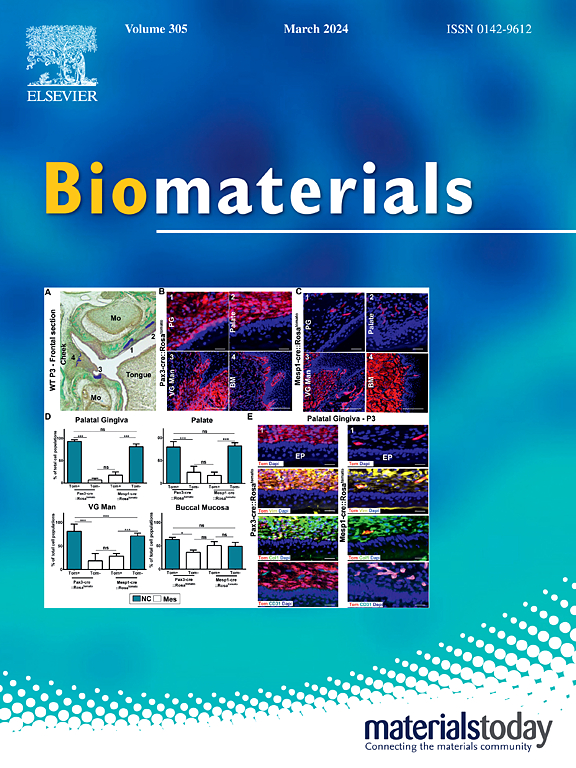大黄素衍生的红色发射碳点:非照明条件下的光驱动ROS生成和抗氧化活性
IF 12.9
1区 医学
Q1 ENGINEERING, BIOMEDICAL
引用次数: 0
摘要
活性氧(Reactive oxygen species, ROS)在生理过程和疾病发病机制中起着双重作用,其精确调控对治疗应用至关重要。在此,我们报告了具有光开关促氧化/抗氧化双功能的红发射碳点(CDs)用于精密纳米医学的合理设计。这些n掺杂CDs由大黄素和尿素通过溶剂热法合成,具有:(1)红光发射(>650 nm)和增强的组织穿透,(2)在光照射下有效生成I/II型ROS,(3)在黑暗中有效清除ROS,以及在体内应用中具有优异的水溶性和生物相容性。密度泛函理论(DFT)计算证实,n掺杂优化了Emo-CDs的光谱特性,促进了ROS的生成。独特的石墨烯类核心具有丰富的表面官能团,可以在黑暗条件下在氧化和抗氧化状态之间可逆切换。这项工作为开发能够精确调节氧化应激的智能治疗药物建立了一个新的范例,在光动力学和抗氧化治疗中具有广阔的应用前景。本文章由计算机程序翻译,如有差异,请以英文原文为准。

Emodin-derived red-emissive carbon dots: Light-driven ROS generation and antioxidant activities in non-illuminative regimes
Reactive oxygen species (ROS) play dual roles in physiological processes and disease pathogenesis, making their precise regulation crucial for therapeutic applications. Herein, we report the rational design of red-emissive carbon dots (CDs) with light-switchable pro-oxidant/antioxidant bifunctionality for precision nanomedicine. Synthesized from emodin and urea via a solvothermal method, these N-doped CDs exhibit: (1) red emission (>650 nm) with enhanced tissue penetration, (2) efficient type I/II ROS generation under light irradiation, (3) effective ROS scavenging in darkness , and superior water solubility and biocompatibility for in vivo applications. Density functional theory (DFT) calculations confirm that N-doping optimizes the spectral properties of Emo-CDs and promotes the generation of ROS. The unique graphene-like core with abundant surface functional groups enables reversible switching between oxidative and antioxidative states under dark conditions. This work establishes a new paradigm for developing intelligent theranostic agents capable of precise oxidative stress regulation, with promising applications in photodynamic and antioxidant therapy.
求助全文
通过发布文献求助,成功后即可免费获取论文全文。
去求助
来源期刊

Biomaterials
工程技术-材料科学:生物材料
CiteScore
26.00
自引率
2.90%
发文量
565
审稿时长
46 days
期刊介绍:
Biomaterials is an international journal covering the science and clinical application of biomaterials. A biomaterial is now defined as a substance that has been engineered to take a form which, alone or as part of a complex system, is used to direct, by control of interactions with components of living systems, the course of any therapeutic or diagnostic procedure. It is the aim of the journal to provide a peer-reviewed forum for the publication of original papers and authoritative review and opinion papers dealing with the most important issues facing the use of biomaterials in clinical practice. The scope of the journal covers the wide range of physical, biological and chemical sciences that underpin the design of biomaterials and the clinical disciplines in which they are used. These sciences include polymer synthesis and characterization, drug and gene vector design, the biology of the host response, immunology and toxicology and self assembly at the nanoscale. Clinical applications include the therapies of medical technology and regenerative medicine in all clinical disciplines, and diagnostic systems that reply on innovative contrast and sensing agents. The journal is relevant to areas such as cancer diagnosis and therapy, implantable devices, drug delivery systems, gene vectors, bionanotechnology and tissue engineering.
 求助内容:
求助内容: 应助结果提醒方式:
应助结果提醒方式:


